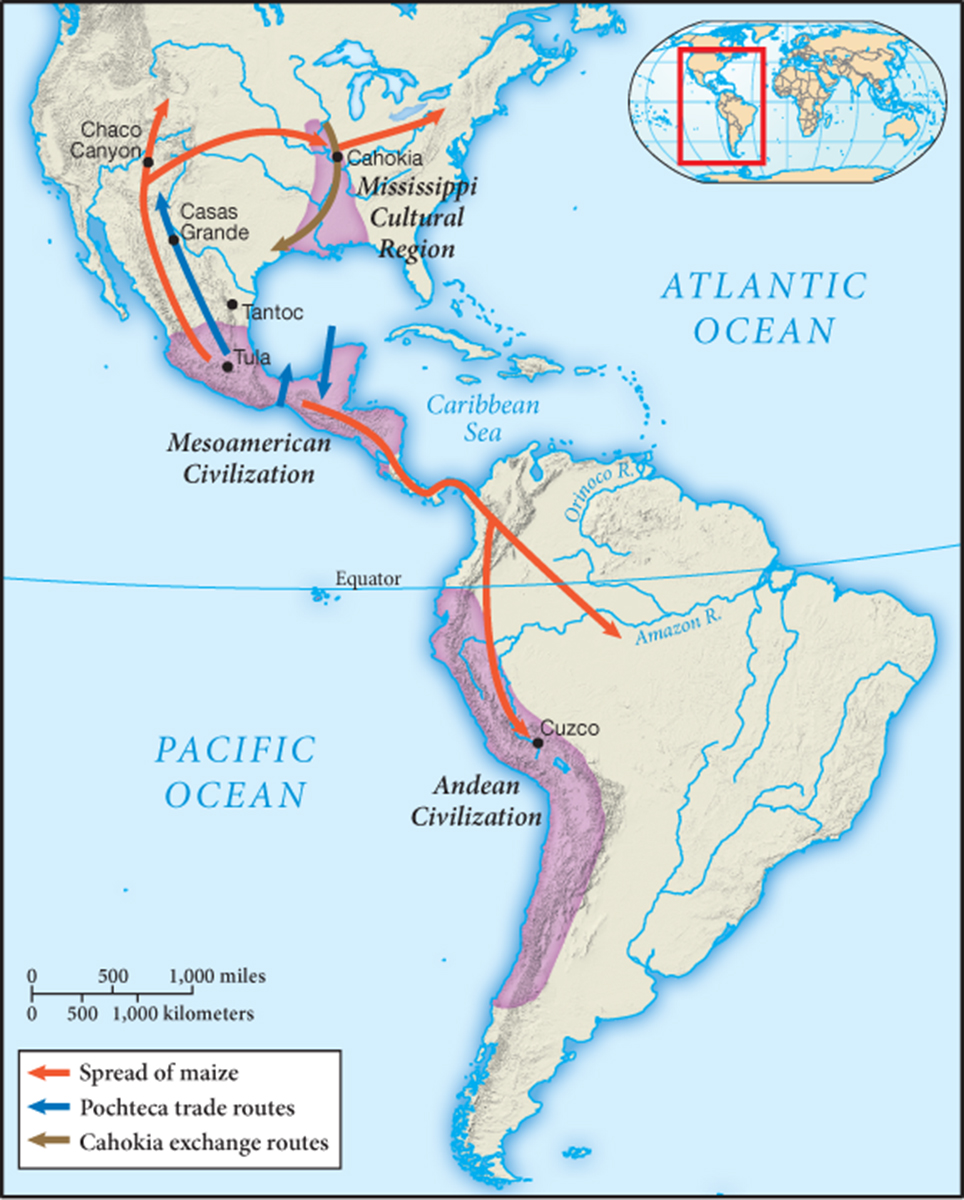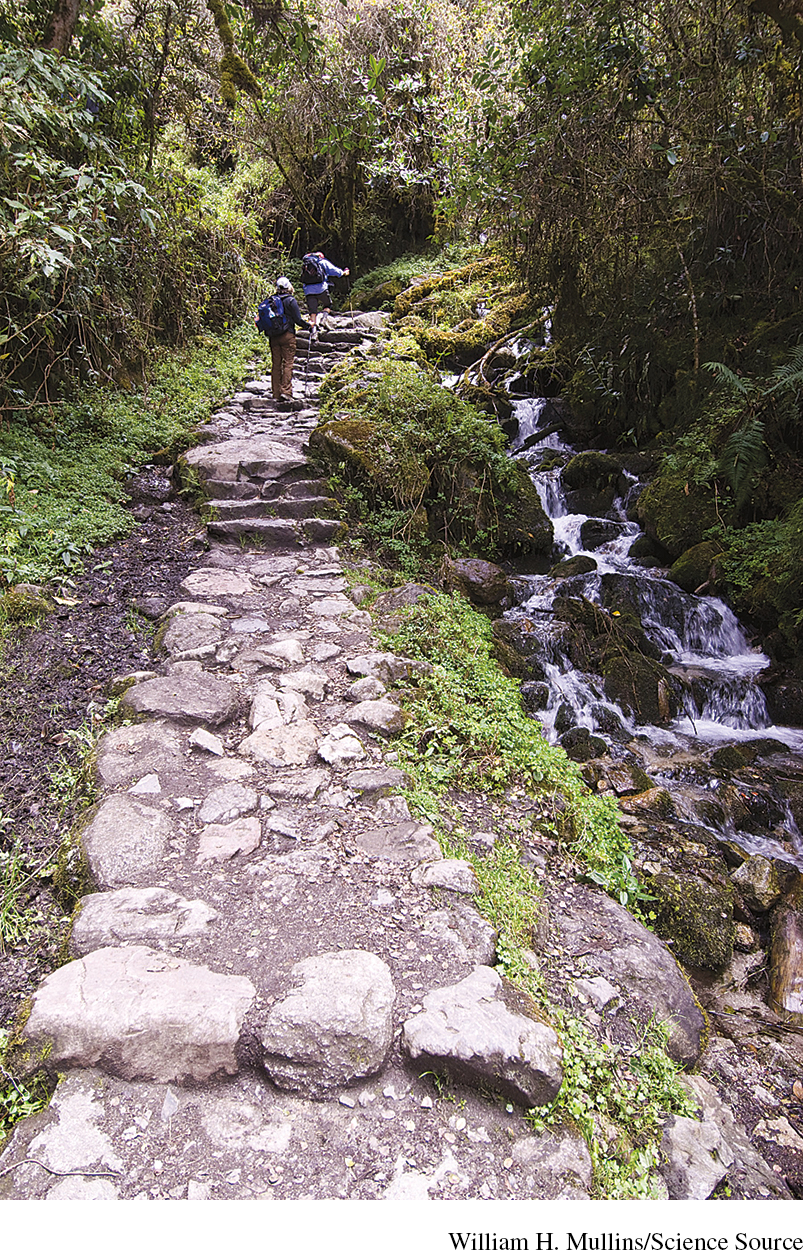An American Network: Commerce and Connection in the Western Hemisphere
Before the voyages of Columbus, the world of the Americas developed quite separately from that of Afro-Eurasia. Intriguing hints of occasional contacts with Polynesia and other distant lands have been proposed, but the only clearly demonstrated connection was that occasioned by the brief Viking voyages to North America around the year 1000. (See Zooming In: Thorfinn Karlsefni.) Certainly, no sustained interaction between the peoples of the two hemispheres took place. But if the Silk, Sea, and Sand Roads linked the diverse peoples of the Eastern Hemisphere, did a similar network of interaction join and transform the various societies of the Western Hemisphere?
In what ways did networks of interaction in the Western Hemisphere differ from those in the Eastern Hemisphere?
Clearly, direct connections among the various civilizations and cultures of the Americas were less densely woven than in the Afro-Eurasian region. The llama and the potato, both domesticated in the Andes, never reached Mesoamerica; nor did the writing system of the Maya diffuse to Andean civilizations. The Aztecs and the Incas, contemporary civilizations in the fifteenth century, had little if any direct contact with each other. The limits of these interactions owed something to the absence of horses, donkeys, camels, wheeled vehicles, and large oceangoing vessels, all of which facilitated long-distance trade and travel in Afro-Eurasia.
Geographic or environmental differences added further obstacles. The narrow bottleneck of Panama, largely covered by dense rain forests, surely inhibited contact between South and North America. Furthermore, the north/south orientation of the Americas—which required agricultural practices to move through, and adapt to, quite distinct climatic and vegetation zones—slowed the spread of agricultural products. By contrast, the east/west axis of Eurasia meant that agricultural innovations could diffuse more rapidly because they were entering roughly similar environments. Thus nothing equivalent to the long-distance trade of the Silk, Sea, or Sand Roads of the Eastern Hemisphere arose in the Americas, even though local and regional commerce flourished in many places. Nor did distinct cultural traditions spread widely to integrate distant peoples, as Buddhism, Christianity, and Islam did in the Afro-Eurasian world.

Map 7.5 The American Web Transcontinental interactions within the American web were more modest than those of the Afro-Eurasian hemisphere. The most intense areas of exchange and communication occurred within the Mississippi valley, Mesoamerican, and Andean regions.
Nonetheless, scholars have discerned “a loosely interactive web stretching from the North American Great Lakes and upper Mississippi south to the Andes.”21 (See Map 7.5.) Partly, it was a matter of slowly spreading cultural elements, such as the gradual diffusion of maize from its Mesoamerican place of origin to the southwestern United States and then on to eastern North America as well as to much of South America in the other direction. A game played with rubber balls on an outdoor court has left traces in the Caribbean, Mexico, and northern South America. Construction in the Tantoc region of northeastern Mexico resembled the earlier building styles of Cahokia, indicating the possibility of some interaction between the two regions. The spread of particular pottery styles and architectural conventions likewise suggests at least indirect contact over wide distances. This kind of diffusion likely extended from the Americas to the Pacific islands as well. Scholars believe that the sweet potato, indigenous to South America, passed into Pacific Oceania around 1000 to 1100 C.E., introduced by Polynesian voyagers who had landed on the west coast of that continent and then returned home with sweet potatoes, which spread widely within Oceania.22
Commerce too played an important role in the making of this “American web.” A major North American chiefdom at Cahokia, near present-day St. Louis, flourished from about 900 to 1250 at the confluence of the Mississippi, Illinois, and Missouri rivers (see “North America: Ancestral Pueblo and Mound Builders”). Cahokia lay at the center of a widespread trading network that brought it shells from the Atlantic coast, copper from the Lake Superior region, buffalo hides from the Great Plains, obsidian from the Rocky Mountains, and mica from the southern Appalachian Mountains. Sturdy dugout canoes plied the rivers of the eastern woodlands, loosely connecting their diverse societies. Early European explorers and travelers along the Amazon and Orinoco rivers of South America reported active networks of exchange that may well have operated for many centuries among densely populated settlements of agricultural peoples. Caribbean peoples using large oceangoing canoes had long conducted an inter-island trade, and the Chincha people of southern coastal Peru undertook a privately organized ocean-based exchange in copper, beads, and shells along the Pacific coasts of Peru and Ecuador in large seagoing rafts. Another regional commercial network, centered in Mesoamerica, extended north to what is now the southwestern United States and south to Ecuador and Colombia. Many items from Mesoamerica—copper bells, macaw feathers, tons of shells—have been found in the Chaco region of New Mexico. Residents of Chaco also drank liquid chocolate, using jars of Maya origin and cacao beans imported from Mesoamerica, where the practice began. Turquoise, mined and worked by the Ancestral Pueblo (see Chapter 6, pages 255–56), flowed in the other direction.

Inca Roads Used for transporting goods by pack animal or sending messages by foot, the Inca road network included some 2,000 inns where travelers might find food and shelter. Messengers, operating in relay, could cover as many as 150 miles a day. Here contemporary hikers still make use of an old Inca trail road. (William H. Mullins/Science Source)
But the most active and dense networks of communication and exchange in the Americas lay within, rather than between, the regions that housed the two great civilizations of the Western Hemisphere—Mesoamerica and the Andes. During the flourishing of Mesoamerican civilization (200–900 C.E.), both the Maya cities in the Yucatán area of Mexico and Guatemala and the huge city-state of Teotihuacán in central Mexico maintained commercial relationships with one another and throughout the region. In addition to this land-based trade, the Maya conducted a seaborne commerce, using large dugout canoes holding forty to fifty people, along both the Atlantic and Pacific coasts.
Although most of this trade was in luxury goods rather than basic necessities, it was critical to upholding the position and privileges of royal and noble families. Items such as cotton clothing, precious jewels, and feathers from particular birds marked the status of elite groups and served to attract followers. Controlling access to such high-prestige goods was an important motive for war among Mesoamerican states. Among the Aztecs of the fifteenth century, professional merchants known as pochteca (pohch-TEH-cah) undertook large-scale trading expeditions both within and well beyond the borders of their empire, sometimes as agents for the state or for members of the nobility, but more often acting on their own as private businessmen.
Unlike in the Aztec Empire, in which private traders largely handled the distribution of goods, economic exchange in the Andean Inca Empire during the fifteenth century was a state-run operation, and no merchant group similar to the Aztec pochteca emerged there. Instead, great state storehouses bulged with immense quantities of food, clothing, military supplies, blankets, construction materials, and more, all carefully recorded on quipus (knotted cords used to record numerical data) by a highly trained class of accountants. From these state centers, goods were transported as needed by caravans of human porters and llamas across the numerous roads and bridges of the empire. Totaling some 20,000 miles, Inca roads traversed the coastal plain and the high Andes in a north/south direction, while lateral roads linked these diverse environments and extended into the eastern rain forests and plains as well. Despite the general absence of private trade, local exchange took place at highland fairs and along the borders of the empire with groups outside the Inca state.

